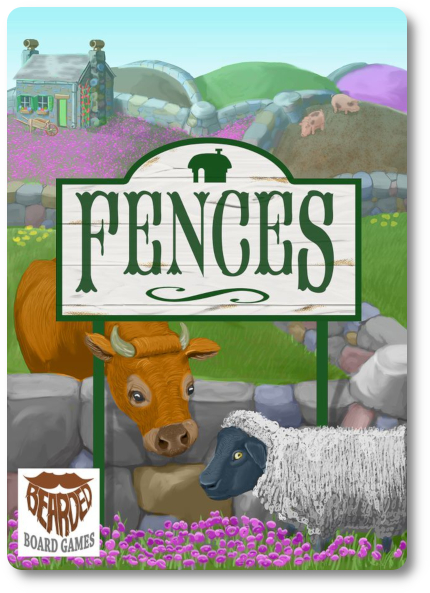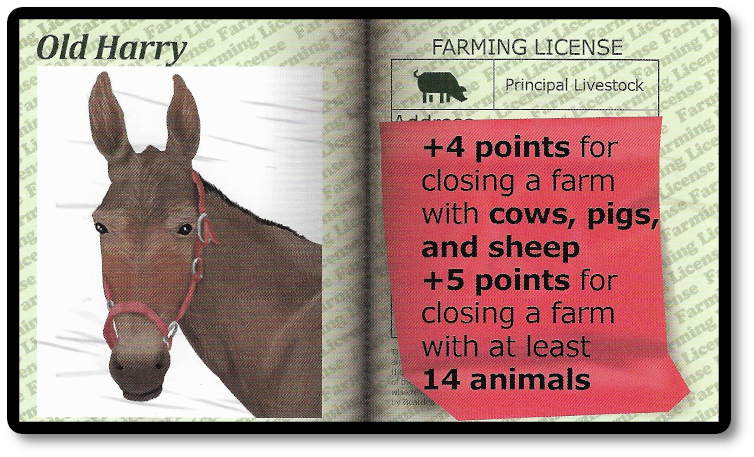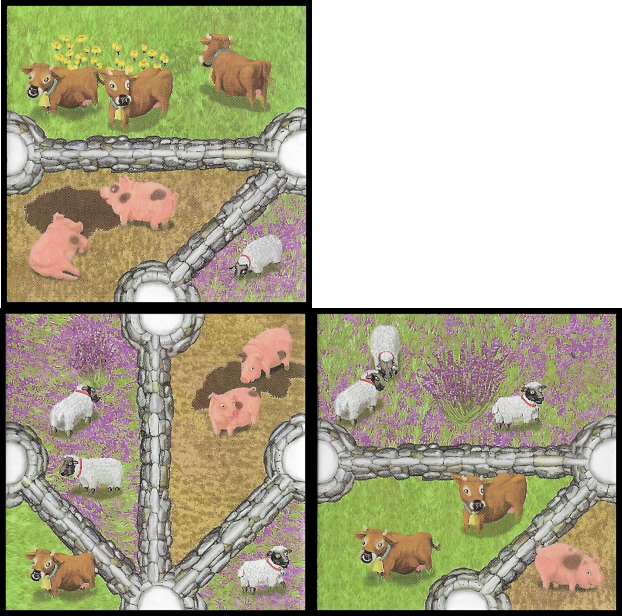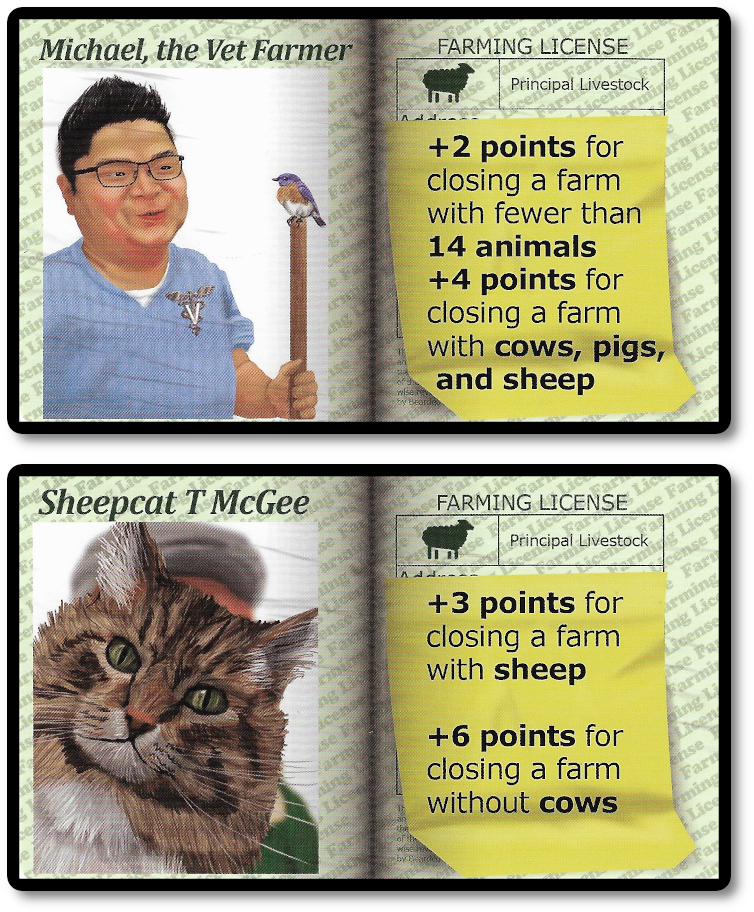
The Basics:
- For ages 8 and up
- For 2 to 4 players
- Approximately 30 minutes to complete
Geek Skills:
- Counting & Math
- Logical & Critical Decision Making
- Pattern/Color Matching
- Strategy & Tactics
- Risk vs. Reward
- Visuospatial Skills
- Hand/Resource Management
- Worker Placement & Area Control
Learning Curve:
- Child – Easy
- Adult – Easy
Theme & Narrative:
- Create the biggest farm as you can
Endorsements:
- Gamer Geek rejected
- Parent Geek approved
- Child Geek approved
Overview
If you own livestock, you need two things right from the start: space and means to enclose said space. In this game, players will take on the responsibility of building their farmland, filling it with as much livestock as they can, and then closing it with fences to ensure the livestock doesn’t run amok. But there is only so much land to go around, and that makes claiming it just as important as building it.
Fences, designed by Adam F. Collins, Tim Forbis and published by Bearded Board Games, is comprised of 84 Land tiles, 36 Farmer Profile cards, 20 Henhouses (in four different colors, five per color), and one scoreboard. The Henhouses are made of wood, the tiles and scoreboard are made of solid cardboard, and the Farmer Profile cards are slightly thicker than your high-quality playing cards. Illustrations on the Land tiles are excellent, clearly showing the different animals with appropriate background colors that make them easy to spot. The Farmer Profile cards are another story. Oh, boy. The shift in artwork that depicts the farms (and cats, and dogs, and even a horse) appear to be inspired by pictures from friends, family, and campaign backers. Not a thing wrong with that, but the shift in the artwork was found by all to be jarring — excellent quality game with some questionable art direction.
Old Harry Had a Farm
To set up the game, first remove several Land tiles per the number of players in the game. Any removed Land tiles are returned to the game box.
Second, take the remaining Land tiles in play and shuffle. This can be done by either putting the tiles in a bag or placing them face-down on the table and moving them around in random directions. I prefer a bag as it allows players to pull tiles blindly, takes less space, and can easily be shared at the table. However you go about it, the randomized Land tiles are referred to as the Supply.
Third, have each player draw two Land tiles from the Supply. These are placed in front of the player. It doesn’t matter if you keep them hidden or not.
Fourth, shuffle the Farmer Profile cards and deal one to each player, face-up. These are placed in front of their owning player. Optionally, have players select their favorite farmer. Here’s mine. Any remaining Farmer Profile cards not used are placed back in the game box.

Fifth, connect the two ends of the Scoreboard and place it to one side where all players can see it. At this time, give each player their five Henhouses all in the same color. Four of the Henhouses will be given to the player who places them by their Farmer Profile card. The fifth Henhouse is placed on the “Start” section of the Scoreboard and is the player’s score marker for the duration of the game.
That’s it for the game set up. Determine who is the first player and begin. Time to tend to the farm!
Don’t Do Fence Me In
Fences is played in turns with no set number of turns per game. A player’s turn is summarized here.
Step One: Place One Land Tile
The player will almost always have two Land tiles available to them. One of them must now be placed in the playing area. Of course, there are rules for setting the Land tiles. Because I’m one hell of a nice guy, I’ll explain how they are placed.
- Each Land tile must be placed adjacent to a previously placed Land tile, with at minimum one full side of the tile touching the entire side of another. None of this connecting diagonally nonsense.
- The fences on the Land tile must meet at the nodes, which are pretty easy to spot on the Land tiles. No good breaking fences in this game.
- The orientation of the Land tile doesn’t matter, as long as it follows the first two rules.

On the off chance that a Land tile cannot be placed, the player takes one of their previously placed Henhouses off the played tiles, returning it to their stock.
Step Two: Review Landscape
If the Land tile placed does not entirely enclose the fields with a fence, the player moves to Step Three.
If the placement of the Land tile completely encloses the fields with one uninterrupted fence, the farmland is now scored. Players now look to see who has a Henhouse in the newly enclosed farmland. Players score one point per field-type controlled by their Henhouse. If the farmland only has one field-type (only cows, for example), the player scores two points per field-type. Henhouses are removed from the completed farmland and returned to their owners.
The player who placed the Land tile that closes the farmland gets to score additional points. On each of the Farmer Profile cards are bonus scoring conditions. If met, the player scores these extra points, as well. The player need not have any Henhouses on the newly enclosed farmland to receive these bonus points. This is important, as sometimes farmland is surrounded without any Henhouses on them.

Farmland may be completed with two or more players controlling the same fields. This will occur if players are building Henhouses on different Land tiles that are initially separated but then brought together through tile placement. If this should come to pass, count the field-types as you would normally and then divide the total points for that field-type evenly among all the players who have claimed it per their total number of Henhouses.
Points are scored and tracked using the Scoreboard and the player’s Henhouse.
Step Three: Build That Henhouse
The player may now optionally place an available Henhouse to the Land tile they just set. Each player only has four to use, meaning their use in the game is limited. Once set, they cannot be removed and do not return to the player until they are scored.
- Only one Henhouse can be placed at a time on a player’s turn.
- The Henhouse can only be placed on the Land tile put into play on the player’s turn.
- If there is more than one field in the Land tile (fields are divided by fences), the player must select one (you cannot ride the fence). A Henhouse can only represent one field per Land tile.
- A player may not place a Henhouse to a field that has a tile connected to a field that is already claimed by an opponent. This is determined by looking at all the other Land tiles the newly placed Land tile is connected to, using the fences as boarders. Regardless of the size or shape of the uninterrupted land, the player may not place their Henhouse on the field if any other Henhouse is already occupying a connected Land tile.
Step Four: Restock the Land
The last action the player takes on their turn is drawing one Land tile. The player now has two to use on their next turn.
This completes the player’s turn. The next player in turn order sequence now goes starting with Step One noted above.
When the Cows Come Home
The game ends when the last Land tile is placed. Score any newly completed farmland as usual. The player with the most points wins the game.
To learn more about Fences, visit the game’s web page.
Final Word
 The Child Geeks had a lot of fun with Fences. It should be noted that it’s becoming harder and harder for me to find Child Geeks with little to no experience, and almost all of our Child Geeks had played Carcassonne in the past. For those who had, they found Fences easy to learn and fast to play. It kept them interested, but they also mentioned several times how easy the game felt. According to one Child Geek, “This feels like an easier version of Carcassonne. I like it because there is less to think about, but still fun to play.” A Child Geek who had not played Carcassonne or any other tile-placement game before was thrilled by it. According to this young enthusiastic future farmer, “Wow! I like how you build your farms, and you can see all the many animals you get to keep. I liked it a lot and want to play it again right away.” When all the votes were in, the Child Geeks gave Fences their full approval.
The Child Geeks had a lot of fun with Fences. It should be noted that it’s becoming harder and harder for me to find Child Geeks with little to no experience, and almost all of our Child Geeks had played Carcassonne in the past. For those who had, they found Fences easy to learn and fast to play. It kept them interested, but they also mentioned several times how easy the game felt. According to one Child Geek, “This feels like an easier version of Carcassonne. I like it because there is less to think about, but still fun to play.” A Child Geek who had not played Carcassonne or any other tile-placement game before was thrilled by it. According to this young enthusiastic future farmer, “Wow! I like how you build your farms, and you can see all the many animals you get to keep. I liked it a lot and want to play it again right away.” When all the votes were in, the Child Geeks gave Fences their full approval.
 Like the Child Geeks, it’s getting difficult to find Parent Geeks with little to no experience. All of our players had previous experience with Carcassonne and tile-placement games. They found Fences to be easy to learn and fast to play. None of them found any flaws in the game, but they did mention that the game itself felt a little too easy at times, and they would typically seek out games with more depth. According to one Parent Geek, “I need to take into account that I have played games like this before, and I like them. This is a good game, and I’d call it great if I have never played games like this. But I have. So I think this is a good game at best.” Another Parent Geek said, “Fun and fast gameplay. A bit easy, but a lot of fun to play with the kids. This feels like a gateway game to me. Something you learn, love, and then move on to something bigger. I’d play it again, but would eventually lose interest.” When all the votes were in, the Parent Geeks agreed that the game was worthy of their endorsement.
Like the Child Geeks, it’s getting difficult to find Parent Geeks with little to no experience. All of our players had previous experience with Carcassonne and tile-placement games. They found Fences to be easy to learn and fast to play. None of them found any flaws in the game, but they did mention that the game itself felt a little too easy at times, and they would typically seek out games with more depth. According to one Parent Geek, “I need to take into account that I have played games like this before, and I like them. This is a good game, and I’d call it great if I have never played games like this. But I have. So I think this is a good game at best.” Another Parent Geek said, “Fun and fast gameplay. A bit easy, but a lot of fun to play with the kids. This feels like a gateway game to me. Something you learn, love, and then move on to something bigger. I’d play it again, but would eventually lose interest.” When all the votes were in, the Parent Geeks agreed that the game was worthy of their endorsement.
 The Gamer Geeks felt that Fences was a poor excuse for a watered-down Carcassonne. They liked the Farmer Profile bonuses but hated using them due to their dislike of the artwork. One Gamer Geek even covered up the artwork with a drink, so they didn’t have to look at it, find it “distracting.” According to one Gamer Geek, “This is a really easy version of Carcassonne. That’s not a bad thing, but nor is it a good thing. This game doesn’t do much in the way that made me feel interested or excited. I won’t be playing it again.” Another Gamer Geek said, “For those who have played games like this, I think they’d find Fences to be boring or too simple. I do think this would be a great game for my kids or even my 88-year-old grandma.” The majority of the Gamer Geeks voted to reject Fences, noting it was a fine game, but not for them or anyone else who had played more complex tile-placement games.
The Gamer Geeks felt that Fences was a poor excuse for a watered-down Carcassonne. They liked the Farmer Profile bonuses but hated using them due to their dislike of the artwork. One Gamer Geek even covered up the artwork with a drink, so they didn’t have to look at it, find it “distracting.” According to one Gamer Geek, “This is a really easy version of Carcassonne. That’s not a bad thing, but nor is it a good thing. This game doesn’t do much in the way that made me feel interested or excited. I won’t be playing it again.” Another Gamer Geek said, “For those who have played games like this, I think they’d find Fences to be boring or too simple. I do think this would be a great game for my kids or even my 88-year-old grandma.” The majority of the Gamer Geeks voted to reject Fences, noting it was a fine game, but not for them or anyone else who had played more complex tile-placement games.
 Fences is not Carcassonne.
Fences is not Carcassonne.
Let’s make sure we get that out of the way immediately. Fences feels similar in its play style, but that’s where any comparison should end. Fences is a more straightforward game, but it throws in a neat new idea of how to score. The Farmer Profiles are essential to the player and should be considered every time the player places a Land tile. The Henhouses are not superfluous by any means, but they should not be regarded as the primary means to score points, either. The Farmer Profile is where it’s at.
As mentioned by our Gamer Geeks, Fences is a bit too easy for the more elitists. Gameplay, while well structured and fast, is also a bit too much in the shallow end to be engrossing. This makes it a great game as a filler and absolutely a must for those looking to introduce a tile placing game to friends, family, and younger players who have no experience in such things. Do not anticipate a lot of depth or subtly in the gameplay. There is none, but that doesn’t distract from the game’s entertainment value. I have found it to be the most enjoyable with a mixed group, primarily made up of adults and kids.
Fences is an excellent game to put on your table if you have younger Child Geeks or inexperienced players who are looking for a game. Easy rules to learn, and the gameplay is fast, keeping even the most distracted player engaged long enough to finish a game or two. While I do not recommend Fences to anyone who has played more complex tile-placement games, this is a title that will get a lot of game time for anyone just starting the hobby. Good stuff as a family game. Do check it out and see if Fences keeps you and your little animals captured at your gaming table.
This game was given to Father Geek as a review copy. Father Geek was not paid, bribed, wined, dined, or threatened in vain hopes of influencing this review. Such is the statuesque and legendary integrity of Father Geek.




Pingback: Fences: The Ranch Game Expansion Review (prepublished version) - Father Geek